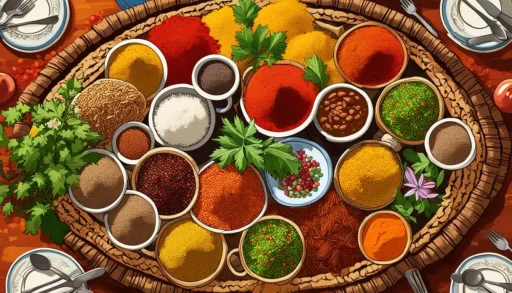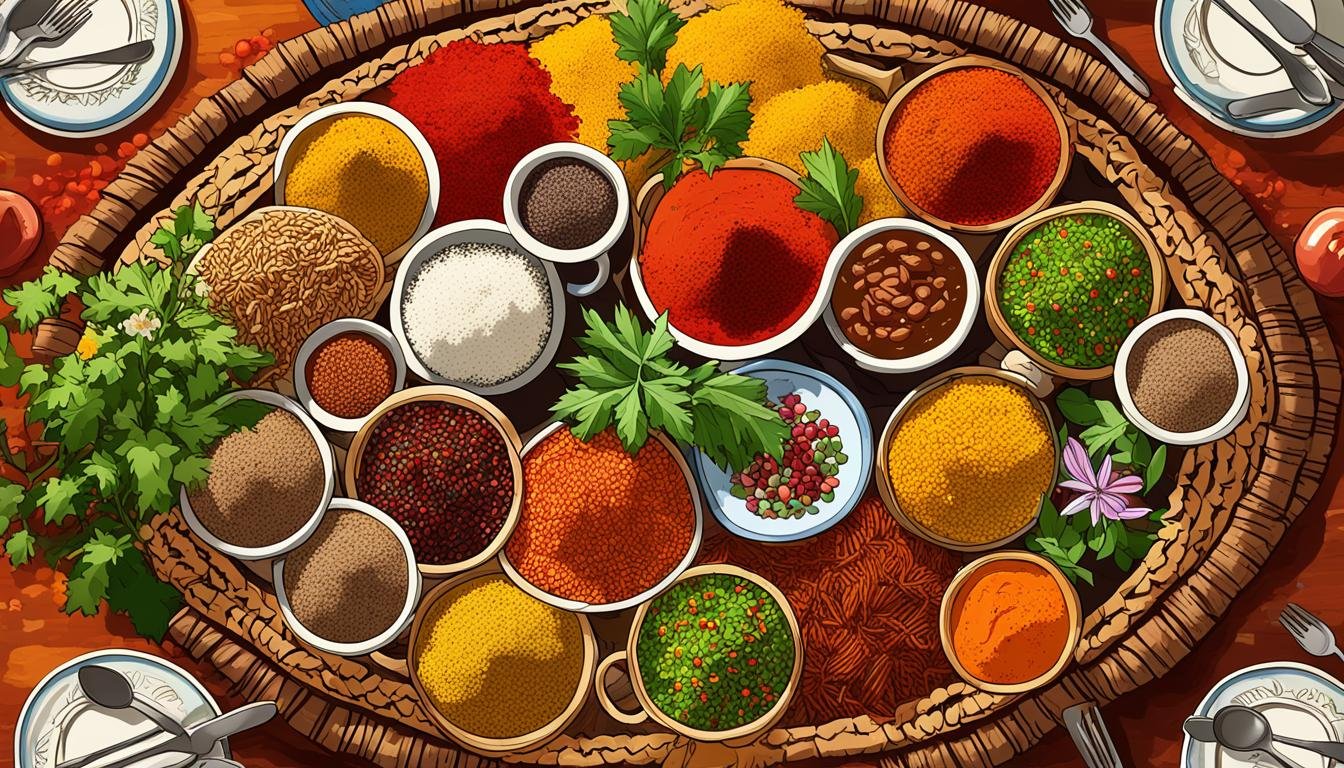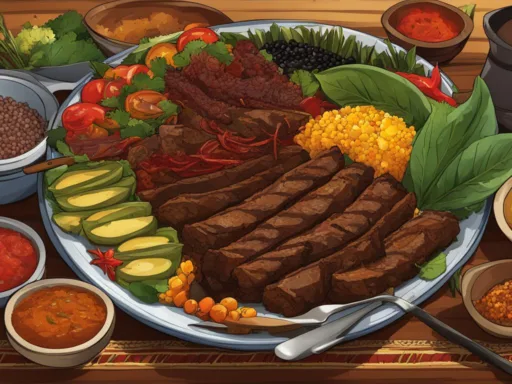Did you know that Ethiopia is one of the few places on earth with its own indigenous written script, calendar, and time system? Equally distinctive is its cuisine—a mesmerizing array of Ethiopian dishes that have remained untouched by outside influence over centuries. Steeped in age-old traditions, an Ethopian Cuisine Guide is your pathway to a culinary heritage marked by robust flavors and unique eating rituals that celebrate community and hospitality. From the fragrant allure of freshly prepared Tibs to the sour tang of traditional Injera, Ethiopian food invites you on a flavorful adventure that’s larger than life. Embark on a voyage through the rich tapestry of traditional Ethiopian cuisine and experience the warmth of Ethiopian culinary culture that has generously opened its kitchens to the world.
Key Takeaways
- Uncover the vibrancy and variety of Ethiopian dishes that celebrate a rich culinary history.
- Learn how communal eating shapes the heart of Ethiopian culinary culture.
- Discover the bold and smoky flavors unique to Ethiopian food, such as the berbere spice.
- Explore how traditional Ethiopian cuisine uses time-honored recipes to connect people and cultures.
- Experience the joy of shared meals with a thoughtful exploration of an Ethiopian Cuisine Guide.
An Introduction to Ethiopian Culinary Culture
Ethiopian culinary culture is a profound expression of the nation’s identity, embodying rich traditions and a strong communal ethos. Preparing and sharing food is a thoughtful art that speaks to the heart of Ethiopia’s social values.
The Role of Food in Ethiopian Society
In Ethiopian society, every meal is a celebration of togetherness and community. The act of sharing a plate signifies trust and friendship, which are invaluable in Ethiopian social circles. Traditional dishes such as Tibs are not just food; they’re a catalyst for gathering, storytelling, and nurturing relationships.
Dining Etiquette and the Significance of Communal Eating
Communal eating in Ethiopia transcends mere dining etiquette; it is a fundamental part of the country’s fabric. Eating from a shared plate is customary, bringing a palpable sense of unity to the table. It is common for friends and family to feed one another, a gesture known as ‘gursha’, strengthening the bonds of kinship.
Understanding the Use of Ethiopian Spices and Herbs
The flavors of Ethiopian cuisine are as bold and vibrant as its cultural mosaic. Utilizing a plethora of spices and herbs, including the iconic berbere spice blend, Ethiopian cooks create a spectrum of flavors that entice the palate. The mastery of these spices and herbs reflects centuries-old Ethiopian cooking techniques that are passed down through generations.
The Legendary Injera: More Than Just Ethiopian Bread
At the heart of Ethiopian dining lies the Ethiopian Injera, a sourdough-risen flatbread with a unique, slightly spongy texture. Far from being just Ethopian bread, it’s a multifaceted staple that truly embodies the essence of Ethiopian culinary tradition.
Considered both a dish and a dining tool, Injera is made from teff grain—a high-fiber, protein-packed grain native to Ethiopia. With its gluten-free composition, Injera offers a nutritious base that complements the vibrant flavors of Ethiopian cuisine, serving as plate and utensil for a variety of spicy wot and other traditional dishes.
The making of Injera is as distinctive as its role on the Ethiopian table. The teff batter is left to ferment, which imparts a characteristic tangy flavor, akin to a sourdough pancake. This fermentation process highlights the culinary innovation where ancient traditions meet time-honored practices, showcasing the ingenuity of Ethiopian cooks.
Integral to the Ethiopian dining experience, the Injera doesn’t just add flavor—it invites diners to engage with their food, tearing pieces to scoop up mouthfuls of savory wot, creating a tactile and intimate mealtime affair.
Here’s a quick look at how Injera stacks up against other global breads:
| Global Bread | Main Ingredient | Texture | Use |
|---|---|---|---|
| Injera | Teff Grain | Spongy and Elastic | Utensil and Plate |
| Naan | Wheat Flour | Soft and Fluffy | Dipping and Wrapping |
| Corn Tortilla | Masa Harina (Corn Flour) | Firm and Flexible | Base for Tacos and Wraps |
| Pita | Wheat Flour | Soft and Pocketable | Stuffing and Dipping |
In summary, the Ethiopian Injera is a culinary marvel that rises above its basic function as Ethiopian bread. This gluten-free, nutritious canvas sets the stage for enjoying Ethiopia’s beloved spicy dishes, making it an indelible part of the nation’s food identity.
Ethiopian Cuisine Guide
Delve into the Ethiopian Cuisine Guide and discover how each dish tells a story of cultural heritage, communal values, and vibrant flavors. This journey through Ethiopian culinary traditions will reveal an enchanting world where recipes are more than mere sustenance—they embody the heart of Ethiopian culture.
Exploring Tibs: Ethiopia’s Iconic Meat Dish
Among the star players of Ethiopian food, Tibs stands out with its sizzling presentation and mouthwatering spice blends. Usually made with prime cuts of beef, lamb, or goat, Tibs is a testament to the country’s love for hearty meats. Join us as we explore the ins and outs of preparing this iconic dish, relishing the aromas of berbere that elevate it to new heights.
Delving into Vegetarian Delicacies: Beyainatu and Shiro
Beyainatu, a medley of beautifully prepared vegetable dishes, presents a bountiful feast that pleases both the eye and palate. As an integral part of Ethiopian culinary culture, this vegetarian platter harmonizes flavors using time-honored Ethiopian recipes, each one rich in stories and taste. Not to be eclipsed, Shiro warms the soul with its thick, spiced stew made from ground chickpeas or broad beans, a beloved comfort food savored across the nation.
The Fascination with Ethiopian Wot Curries
At the heart of Ethiopian specialties lie the Wot curries, each simmered in seasoned complexity and boldness. Doro Wot, a chicken stew deeply infused with spices, and Siga Wot, a beef curry layered with nuanced favors, are quintessential dishes that showcase the depth of Ethiopian spice mastery. These curries are not just dishes but celebrations, served in gatherings that cement bonds and create lasting memories.
As this guide takes you through the landscapes of delectable meats, wholesome vegetarian plates, and intense curries, you’ll gain insight into the vast spectrum of Ethiopian dishes that collectively represent the soul of this incredible Ethiopian cuisine guide.
Ingredients That Define Ethiopian Cooking
The essence of Ethiopian cuisine can be largely attributed to the harmonious blend of Ethiopian spices and ingredients that offer an array of flavors, colors, and textures to every dish. At the heart of this culinary tradition is berbere, a vibrant spice mixture that sings with warmth and depth. Its robust character is derived from a combination of red chilis, garlic, and fenugreek, among other spices, which lay the foundation for many signature Ethiopian dishes. Integrating these elements not only imparts incredible taste but also reflects the country’s respect for its rich agricultural tapestry.
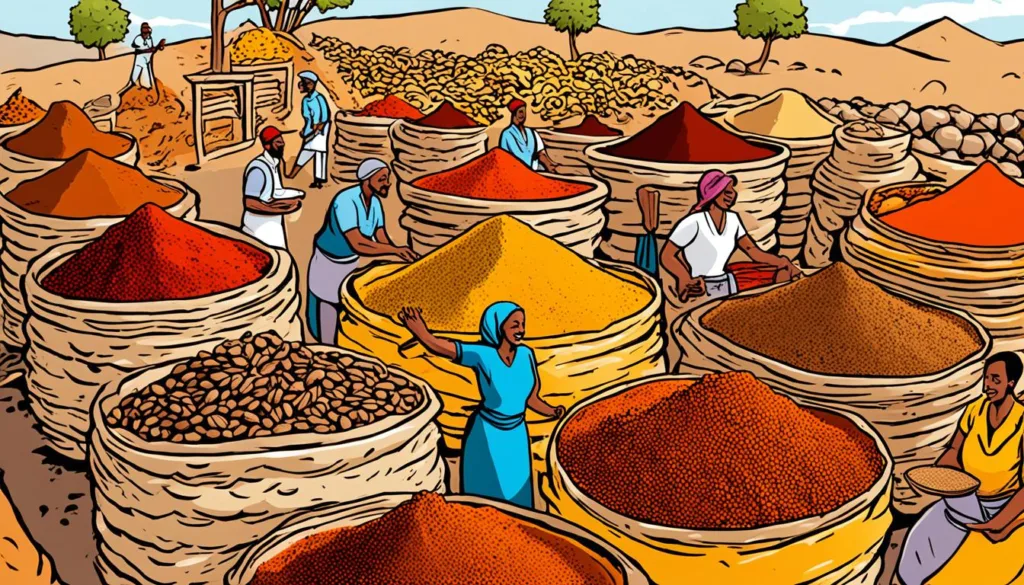
Fresh, home-ground spices are a common sight in Ethiopian kitchens, with berbere taking the coveted spot of being the most iconic. However, to truly appreciate the breadth of Ethiopian flavor, one must not overlook the less celebrated yet equally integral Ethiopian ingredients that punctuate the nation’s pallet. Sacred basil, known as tulsi in local vernacular, alongside bishop weed and rue seeds, might be rare finds outside of Ethiopia, but within the country, they are considered indispensable.
- Red Chilis – responsible for the heat that dances on the palate
- Garlic – adds a pungent depth, rounding out the spice mix
- Fenugreek – imparts an aromatic bitterness and enhances the complexity of flavors
- Sacred Basil – offers a subtle, earthy sweetness
- Bishop Weed and Rue Seeds – these local gems introduce a unique peppery note
Moreover, the beloved injera, with its spongy texture and slight tanginess, is made from the ancient teff grain native to Ethiopia. This pivotal ingredient not only spotlights the Ethiopian way of life but also demonstrates the country’s reliance on and celebration of local produce. The enchantment of Ethiopian cuisine lies not just in the vivacity of its Ethiopian spices, but also in the wholesome and nourishing grains such as teff that have been sustaining generations.
A Flavorful Medley: Ethiopian Recipes for Home Cooking
Embracing the rich traditions of Ethiopian cooking at home can be a delightful and rewarding endeavor. With the right blend of spices and an understanding of key Ethiopian cooking techniques, anyone can recreate the vibrant flavors that characterize this unique cuisine. Whether you’re a seasoned chef or a novice in the kitchen, these traditional Ethiopian recipes will transport your palate to the heart of East Africa.
The Key to Perfectly Spiced Dishes: Homemade Berbere Recipe
One essential component in Ethiopian recipes is the renowned berbere spice mix. This homemade berbere is the backbone of many Ethiopian dishes, imparting a warm, deep flavor, and satisfying heat that is hard to resist. Here is an easy-to-follow recipe to make your own:
- Red chili powder
- Garlic powder
- Fenugreek
- Ginger
- Cardamom
- Coriander
- Cloves
- Cinnamon
- Allspice
- Salt
Mix these spices in equal parts, adjusting the heat with the chili powder to suit your taste. Store in an airtight container, ready to use in a variety of dishes for that authentic Ethiopian flavor.
Vegetarian Favorites: Gomen and Misir Wot Preparation
Vegetarian Ethiopian cuisine is a feast of flavors, and dishes like Gomen and Misir Wot perfectly showcase the nation’s love for hearty vegetable-based meals. Gomen, a dish of simmered collard greens, and Misir Wot, a rich spiced red lentil stew, are staples in the Ethiopian diet and are surprisingly simple to prepare with homemade berbere lending its signature flavor to both.
| Ingredient | Gomen (Collard Greens) | Misir Wot (Spiced Red Lentils) |
|---|---|---|
| Collard Greens | 1 lb, chopped | — |
| Red Lentils | — | 1 cup |
| Berbere Spice Mix | 2 tbsp | 3 tbsp |
| Onions | 1 medium, chopped | 1 medium, chopped |
| Garlic | 4 cloves, minced | 4 cloves, minced |
| Niter Kibbeh (Clarified Butter) | 2 tbsp | 2 tbsp |
| Water | 3 cups | 4 cups |
Sauté onions, garlic, and spices in niter kibbeh until aromatic before adding the greens or lentils and water. Simmer until the greens are tender and the lentils are creamy. Adjust seasoning to taste, and serve warm with injera.
Savory and Succulent: Mastering the Art of Making Tibs
Tibs is a beloved Ethiopian dish, consisting of pan-seared meat seasoned with herbs and spices. To recreate this classic at home, marinate your choice of cubed meat in a mix of berbere, garlic, and rosemary, then sauté in niter kibbeh until browned and tender. Pair with injera or rice for a complete meal.
With these recipes and a sprinkle of patience, you can bring a taste of Ethiopian tradition into your home cooking. Savor each spice and celebrate the vegetarian wonders of Ethiopian cuisine, from the comfort of your own kitchen.
The Rich Tradition of Ethiopian Coffee Ceremonies
One cannot fully appreciate Ethiopian coffee culture without delving into the intricate and communal Ethiopian coffee ceremonies. These traditional rituals are not just about drinking coffee; they embody a profound social significance that has endured for centuries. The ceremony begins with the careful selection and washing of green coffee beans, which are then roasted in a pan over a small flame. The rich aroma signals the start of a communal gathering, an event that weaves the social fabric of Ethiopian society tighter with each sip.
The process is meticulous and deliberate, symbolizing the importance of hospitality in Ethiopian communities. Once the beans achieve a rich, dark color, they are ground by hand and brewed in a clay coffee pot known as a ‘jebena’. The final product is served in small cups, often with a side of traditional snacks like popcorn or ‘kolo’. It is common for the host to go through three rounds of serving coffee, each with its own name: ‘Abol’, ‘Tona’, and ‘Baraka’, signifying a progression in strength and spiritual blessing.
Participating in an Ethiopian coffee ceremony connects individuals to the deep-rooted traditions that coffee cultivation has fostered in the country. It’s a ritual that embodies the spirit of community; an essential aspect of the vibrant Ethiopian coffee culture.

- The washing, roasting, and brewing steps in the ceremony
- The communal aspect of gathering and conversing
- The significance of the three rounds of serving coffee
Coffee in Ethiopia transcends the mere act of consumption; it is a ritual that forges bonds, marks times of peace, and celebrates community.
| Aspect | Detail |
|---|---|
| Green Coffee Beans | Selected and washed to begin the ceremony |
| Roasting Process | Beans are roasted in a pan, filling the air with aromatic scents |
| Brewing Method | Ground beans are brewed in a ‘jebena’ for an authentic taste |
| Serving Rounds | Three servings called ‘Abol’, ‘Tona’, and ‘Baraka’ each increasing in strength |
| Communal Impact | Provides an opportunity for socializing and strengthening community bonds |
This ancient practice is far more than an essential start to the day; for Ethiopians, it’s a cherished pause life, a time-honored cultural event that proudly showcases Ethiopia’s gift to the world—its coffee.
Ethiopian Street Food: A Bite into Quick Ethiopian Delights
A stroll through Ethiopia’s bustling streets reveals a world where culinary delights are dished out with speed and savored with zest. The aroma of Ethiopian street food fills the air, a testament to a rich food culture where every bite is imbued with history and flavor. These quick bites are not only delectable but also an integral part of the traditional Ethiopian cuisine. From morning markets to evening bazaars, every corner offers an authentic taste of Ethiopia’s street culinary landscape.
From Sambusa to Tere Siga: Street Foods That Delight
As you weave through the energy of street vendors and food stalls, you’re greeted by the famous Sambusa, a triangular pastry beloved across the nation. Stuffed with lentils, spices, and sometimes meat, Sambusas are the perfect snack for those on the move. Then there’s Tere Siga, a bold dish for the daring, featuring raw meat cut into chunks and served with mitmita spice, catering to a palate accustomed to robust and unadulterated flavors intrinsic to Ethiopian dishes.
Navigating Through Ethiopian Spice Markets
Exploring the spice markets is akin to a sensory voyage, where vibrant hues and piquant scents of freshly ground spices fill the air. The markets are where tradition meets the everyday; they are the lifeblood of Ethiopian cuisine, supplying the essential spices that make the street food stand out. Among the stalls, you’ll uncover the foundations of Ethiopian dishes: berbere, shiro, and korerima. These markets not only provide ingredients but also serve as culinary hubs where recipes are shared, and cooking secrets are passed down through generations.
Dining Out: The Ethiopian Restaurant Experience
Embarking on an Ethiopian dining adventure is about more than just a meal; it’s an insightful foray into a culture steeped in tradition. At your local Ethiopian restaurant, you’re not just a customer – you’re a guest being ushered into a world where the cuisine is a vibrant storyteller, painting a picture of a land defined by rich spices, shared plates, and a history of communal connections.
Amidst the tantalizing scents of simmering stews and freshly roasted coffee, an Ethiopian restaurant provides an authentic backdrop for a multisensory experience. Imagine sitting in a space where the walls are adorned with intricate artwork that echoes the colors and life of Ethiopia, while the air hums with the melodies of traditional music – all coming together to create a feast for the senses.
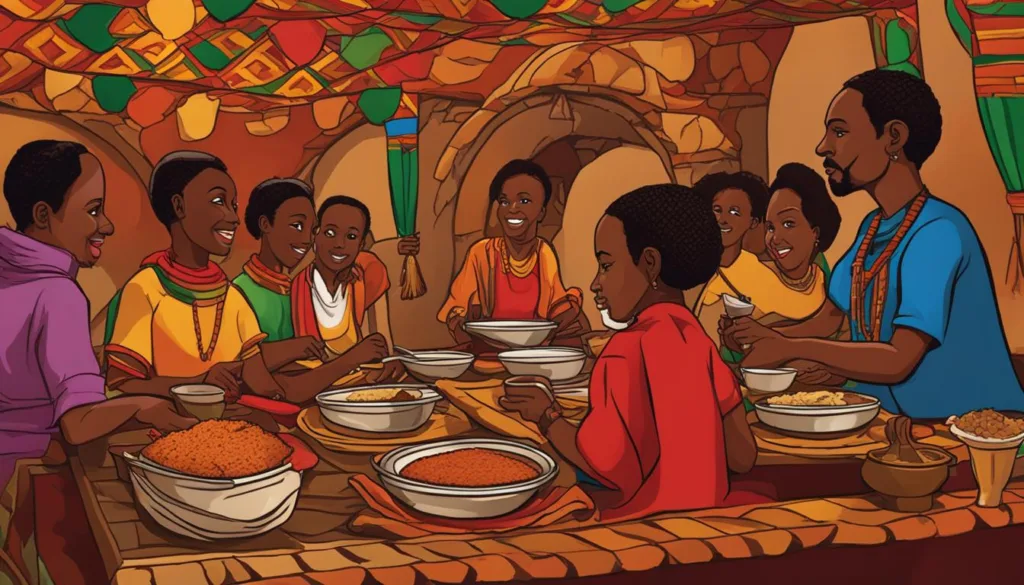
“An Ethiopian restaurant is not just a place to eat; it’s a place to learn, to share, and to savor the tastes that have been lovingly passed down through generations.”
While the allure of Ethiopian dining is robust, navigating the menu can be an adventure in itself. Below is a simple guide to some staple dishes and beverages you might encounter, each offering a peek into the heart of Ethiopian culinary arts.
| Dish/Beverage | Description | Typical Ingredients |
|---|---|---|
| Tibs | Sautéed or grilled meat dish | Meat, onions, peppers, garlic, rosemary, traditional spices |
| Injera | Spongy sourdough flatbread | Teff flour, water, salt |
| Doro Wot | Spicy chicken stew | Chicken, boiled eggs, berbere, onions, butter |
| Shiro | Ground chickpea stew | Ground chickpeas, spices, tomatoes, garlic |
| Beyainatu | Vegetarian mixed platter | Varied vegetable dishes, lentils, salads, injera |
| Ethiopian Coffee | Ritually prepared coffee | Freshly ground coffee beans, water |
As you partake in the traditional bounty spread across a communal injera, remember that the essence of Ethiopian dining is the joy of shared plates and stories. Your experience at an Ethiopian restaurant is an invitation to partake in a legacy of hospitality deeply rooted in the fabric of its society.
Whether you’re drawn by the warmth of the welcome, the depth of the flavors, or simply the craving for a new culinary journey, an Ethiopian restaurant offers an enriching cultural foray that is as rewarding to the palate as it is enlightening to the soul.
Regional Variations of Ethiopian Dishes
The rich topography of Ethiopia yields a tapestry of flavors and dishes unique to the various regions of the country. From the highlands to the coastal areas, each locale contributes its own signature to what can be collectively recognized as traditional Ethiopian cuisine. In order to appreciate the Ethiopian food diversity fully, one must understand the regional differences and influences that shape the culinary landscape of this vibrant nation.
Highland and Lowland Culinary Differences
The highlands of Ethiopia are known for robust, hearty dishes that reflect the agricultural bounty of the area. Teff, which is used to make Injera, thrives in this region. Lowland culinary traditions, however, are shaped by the semi-arid climate and nomadic lifestyle. Ingredients are often sourced from pastoral resources, with an emphasis on meats and dairy products. These contrasting ecosystems result in diverse cooking traditions that remain united under the umbrella of Ethiopian gastronomy.
Coastal Influences on Ethiopian Food
The Ethiopian coastal areas, by the virtue of their proximity to water bodies, have a distinct impact on the local diet. Freshwater fish dishes, such as Asa or fried Nile perch, introduce a seafood element that is not typically found in the highland and lowland regions. These coastal flavors add another dimension to Ethiopian food diversity, underscoring the role of geography in the nation’s culinary narrative.
Ethiopian Festive Foods and Celebratory Customs
Immersing oneself in traditional Ethiopian cuisine during festive times is a joyous celebration of the country’s rich cultural heritage. Ethiopian festive foods are not just meals; they are a narrative of history, camaraderie, and tradition. Each dish served during these events stands as a tribute to Ethiopia’s collective spirit and genuine love for shared, joyful dining experiences. The centerpiece of these celebrations is often Doro Wot, a spicy chicken stew that is lovingly prepared and eagerly anticipated by all attending the feast.
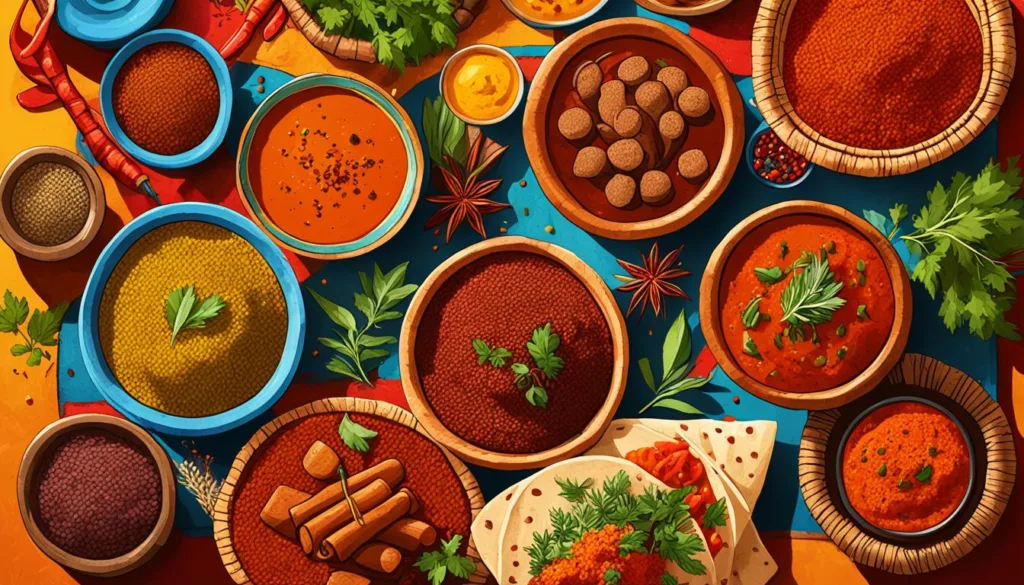
In Ethiopia, food preparation for holidays is an all-encompassing affair. Ingredients are selected with great consideration, and the cooking process is an art in itself. As families congregate to engage in the preparation of the meal, the act becomes an embodiment of connection and unity, reinforcing ties that extend well beyond the dining table.
Each bite of an Ethiopian festive dish is laden with complex flavors and centuries of perfected cooking techniques, celebrating not just a culinary masterpiece, but also the conviviality and warmth that Ethiopian cuisine cultivates amongst those who share in it.
Ethiopian festive foods bring to the table an array of vibrant spices and savory delights, designed to envelope the taste buds in an unforgettable experience. Here is a glimpse of the festive fare:
- Doro Wot – A spicy chicken stew, rich with berbere and butter, traditionally served during important holidays like Meskel and Timkat.
- Kitfo – Minced raw beef seasoned with spicy mitmita and niter kibbeh, typically seen during special occasions, symbolizing trust and kinship amongst diners.
- Injera – The quintessential Ethiopian flatbread, used as a base to beautifully present and enjoy these holiday staples.
The vibrancy of Ethiopian festive gatherings is further augmented by the customary coffee ceremony, a hallmark of Ethiopian hospitality and friendship. This ceremonial brew is often shared after the meal, perfuming the air with its rich aroma, signifying a perfect conclusion to a collective celebration of culture through food.
Celebratory dishes such as these not only tantalize the palate but also perpetuate the age-old traditions of Ethiopia, uniting people through the act of sharing and solidarity. With every festive gathering and every shared meal, the stories of ancestors and the spirit of Ethiopian togetherness are kept alive and cherished by every generation.
Adapting Ethiopian Cuisine for an International Palette
The allure of Ethiopian cooking techniques has transcended its native borders, captivating global diners with the aromatic spices and textures unique to the Horn of Africa. Through a delicate balance of time-honored practices and a willingness to explore, Ethiopian cuisine is stirring the pot on the international food scene, contributing to a richer, more varied global tapestry of flavors.
From the bustling streets of Addis Ababa to cosmopolitan cities around the world, fusion Ethiopian cuisine is an evolving art form. It invites chefs and food enthusiasts alike to experiment with a palate that embraces everything from the spongy complexity of injera to the bold depth of berbere. The result is an exciting fusion that merges traditional Ethiopian delicacies with disparate culinary customs, crafting an unprecedented dining narrative.
The Global Influence of Ethiopian Culinary Practices
As Ethiopian cooking methods enrich the lexicon of international Ethiopian food, a dialogue between diverse culinary traditions begins. The very essence of these cuisines, from intricate spice blends to community-centered meal presentations, offers a profound statement on the nature of cultural exchange and the universal language of gastronomy.
Fusion Restaurants and the Melding of Culinary Traditions
The emergence of fusion restaurants has introduced a contemporary twist to Ethiopian classics, pushing the boundaries of creativity while respecting the integrity of the original dishes. In the hands of visionary chefs, a harmonious blend of flavors pays homage to Ethiopia’s vast gastronomic heritage while inviting the uninitiated to partake in an epicurean journey.
| Ethiopian Ingredient | International Twist | Fusion Dish Example |
|---|---|---|
| Injera | Gluten-Free Crepe Alternative | Injera Tacos with Global Fillings |
| Berbere | Barbecue Rubs and Marinades | Berbere-Spiced Barbecue Ribs |
| Teff | Health-Conscious Grain Bowls | Teff and Quinoa Power Bowl |
| Shiro | Dip for Artisan Flatbreads | Shiro Hummus Fusion with Crudites |
Ethiopian cuisine’s adaptability ensures that its culinary customs will continue to influence international food landscapes. These fusion experiences not only celebrate Ethiopian flavors but also signify a convergence of cultures, enriching the global culinary community one dish at a time.
Conclusion
In closing, the Ethiopian Cuisine Guide presents not just a meal but an entire culture served on a platter. This vibrant cuisine steeped in tradition offers more than the sum of its spices, expanding palates and connecting friends, families, and strangers. The time-honored Tibs and the aromatic Wot curries showcase the compelling punch of Ethiopian flavor profiles, while the fundamental injera bread and revered coffee ceremonies reveal the profound communal essence embodied in Ethiopian culinary culture.
As this guide navigates you through the intricate maze of Ethiopia’s culinary heritage, it reiterates the strong communal bonds fostered by shared dining experiences. Culinary customs that have been honed for centuries now proudly take their place on the global stage, inviting food enthusiasts to celebrate a heritage that values unity and hospitality above all.
The allure of Ethiopian cuisine lies in its ability to transcend cultural barriers, drawing diners into a world of taste that’s as rich in history as it is in flavor. Whether indulging in a homely stew, partaking in a coffee ritual, or venturing into the buzzing street food scenes, Ethiopian dishes offer a passport to an enriching and savory adventure with each delightful mouthful.
